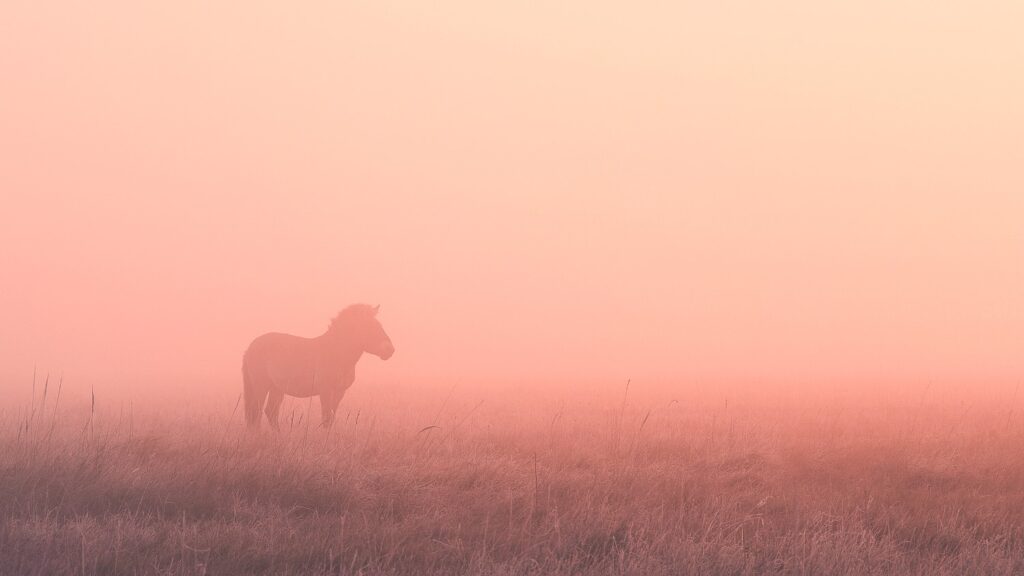The Pentezug in Hortobágy is one of the last wilderness in Hungary, an untouched and unique habitat, home to rare plants, birds, and endangered wild horses. Attila Korbely and Kata Ozogány followed the inhabitants of Pentezug for four seasons and captured rare events, unique moments of the wild world of Przewalski’s horses.
Through their images, we can see up close the wild foals born in the chamomile sea that covers the wilderness, the mischievous play of young colts, and the bloody battles of stallions wildly defending their harem. In the steamy images of the morning, we almost feel the freezing cold as the October air fills with the sound of the cranes, and as ice is deposited on the ox saliva strands like a string of pearls.
One of the special features of the exhibition is that some of the pictures were not taken with a camera, but with a 4k RED Digital Cinema camera, with which Attila and Kata shot a nature film about wild horses. The recording speed of RED cameras reaches 120 frames per second at high resolution, so the images are frozen motion picture frames that gently wash away the dynamic motion. The recordings are presented on fading, artistic giclée paper, the matte surface of which highlights the dreamlike, watercolor-like moments. on the latest research directions to understand the behavior of wild horses. Art, research, and nature conservation as three pillars,

PRZEWALSKI-LOVAK
The Przewalski horse (Equus ferus przewalskii) is the last true wild to survive to this day, never domesticated or ridden, unlike mustangs and Australian brumby, which are actually wild domestic horses. The Przewalski horses are the last wild descendants of the wild horses depicted in prehistoric cave paintings that once inhabited the grassy steppes of Eurasia. It was thought to be extinct for a long time until its last population was discovered on the Mongol Plateau in 1881, but it became extinct in the wild a hundred years later.
Saved from total extinction by the zoos ’careful species rescue efforts, the 12 purebred individuals remaining in captivity became the basis for an international program that has resulted in a world population of around 2,500, of which roughly 800 individuals live wild again in the Mongol Plateau. The Pentezugi Wildlife Sanctuary, which joined the program, was founded in 1997 by the Hortobágy National Park and the Cologne Zoo, with the aim of researching their natural behavior beyond the survival of wild horses and restoring the ecological balance of this rare habitat. The stud, which has grown to three hundred individuals, is the second-largest herd in the world. Several specimens of Pentezugian wild horses were returned to the wild. Their conservation status is still under threat.
PENTEZUG
The endless grassy plain of the Pentezug formed after the Ice Age. The uniqueness of the highly protected habitat hidden in the heart of Hortobágy lies in the rare, unchanged saline plant associations. The flora of the landscape was grazed by ungulates millennia ago, so two originally native but long-extinct species were introduced to the area twenty years ago to maintain Pentezug’s exceptional and today vulnerable ecosystem. Thanks to the presence of Przewalski’s horses and reconstructed primroses, the reeds have opened up, providing shelter for protected birds. A reserve where the rescue of endangered wildlife and the natural maintenance of the habitat could have come into special harmony.
Zita Kovács, Director of the Hortobágy National Park Directorate, will greet you at the opening of the exhibition starting at 2 pm on September 11th; And from 3 p.m., screenings and educational presentations await the audience. István Sándor, ecologist, former director of HNPI, on nature conservation; about the research Katalin Ozogány, researcher of the DE Evolutionary Zoology Department; Attila Korbely, a QEP photographer and nature filmmaker, will talk about art.
The exhibition can be seen free of charge until September 21st during the opening hours of the Kölcsey Center (Debrecen, Hunyadi u. 1-3.), Daily from 9.00 a.m. to 7:00 p.m.